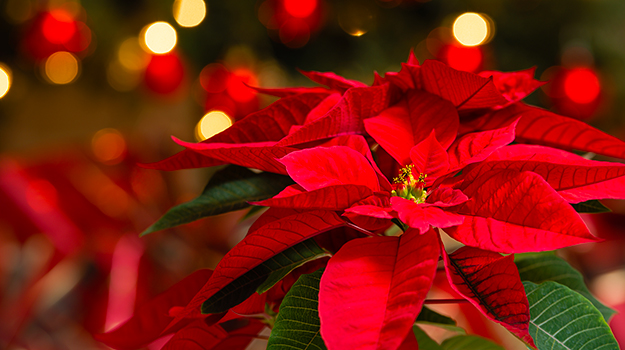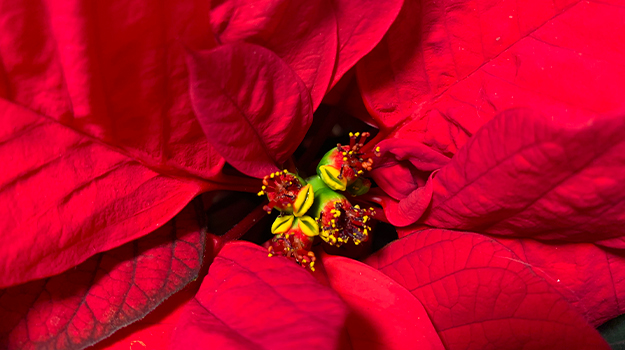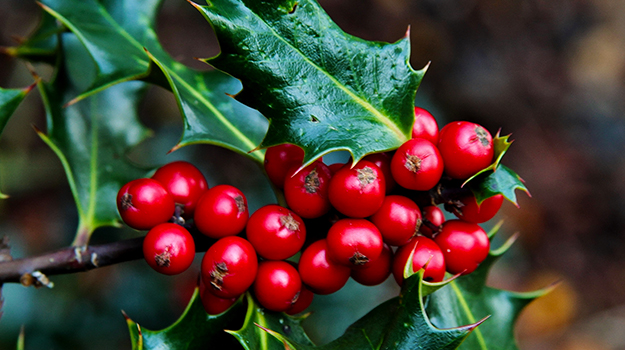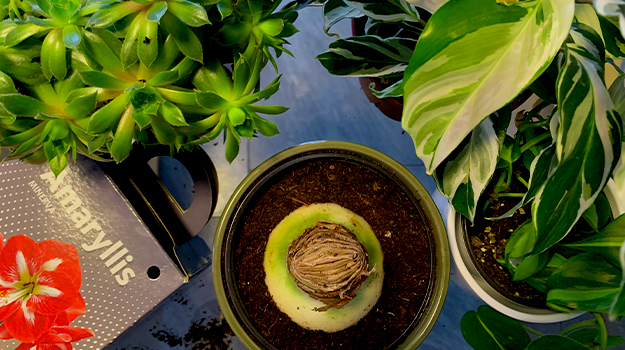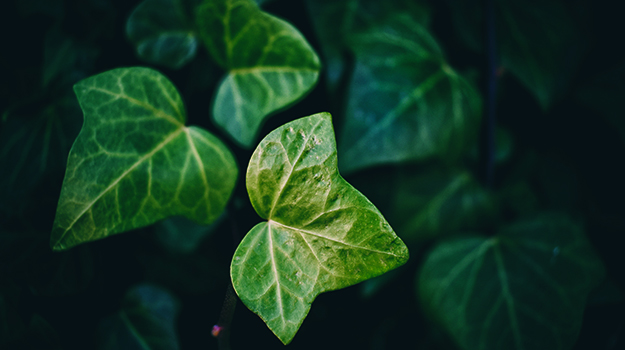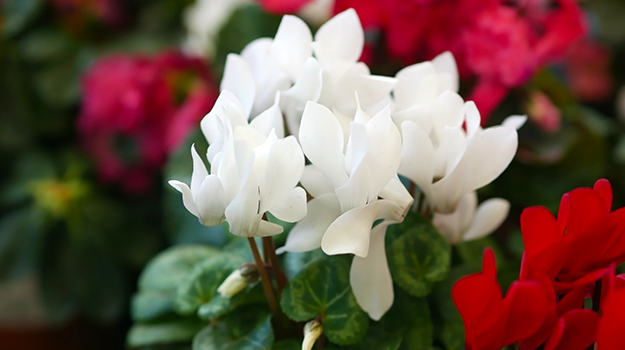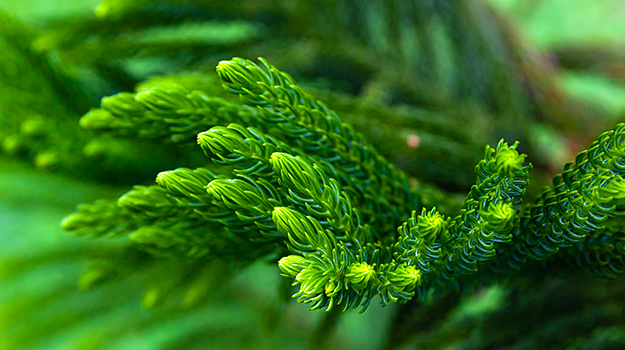Other than the traditional Christmas tree, several plants are at their peak during the Holiday season. Why not add some to your Christmas decor to brighten up your festivities even more?
Just as some plants symbolize the arrival of spring, others are traditionally associated with the Holiday season. Here are some that will assuredly add a touch of life and magic to your Christmas decorations.
May your Christmas be a colourful one!
Poinsettia
When we think of Christmas, the poinsettia is one of the first images that come to mind. Originally from Mexico or Central America, its name means “the most beautiful”.
Traditionally, the poinsettia was red, but we can now get varieties whose bracts remain white, yellow, ivory, pink or even tinted with blue, mauve or turquoise, until April. With a little glitter, the poinsettia is at the heart of all festivities.
You can get your poinsettia to bloom again, but this will require some effort.
How to care for your poinsettia
Poinsettias hate the cold and direct light, and a too warm environment will reduce their blooming period. To prevent the leaves and colourful bracts from drying out, water regularly with temperate water.
How to get a poinsettia to turn red
To get your plant to turn red again, you must reduce its exposure time to natural light. From September, and for a period of eight weeks, place it in a room lit by natural light, but provide complete darkness 14 hours a day.
Holy
Almost as popular as the poinsettia, we see it everywhere on wrapping paper, greeting cards and linens during the Holiday season. It is easily recognized by its red fruits and its prickly and very decorative leaves.
However, it is more often seen in the garden in the summer than indoors in our Christmas decors. This is because holly, which is hardy enough to be planted in our gardens, does not have evergreen foliage like that of Europe.
In winter, its pretty branches loaded with red fruits spend the winter wrapped in jute or geotextile.
Mistletoe
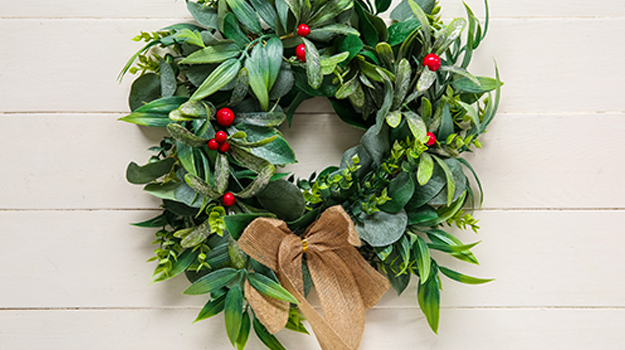
The tradition of kissing under mistletoe is more popular in Europe, where they use real mistletoe, than it is in North America, as we generally have to settle for a more or less realistic plastic plant.
Mistletoe is a parasitic plant that lives at the expense of a host tree. It does not grow in our regions, which makes it very difficult to obtain even a few fresh branches. There is a similar mistletoe, native to the southern and western United States, but it does not seem to encourage hugs.
Amaryllis
The amaryllis is simply spectacular with its immense flowers emerging from large, fleshy bulbs just 6 to 8 weeks after being planted. They develop at the tip of 90-cm-long flower stalks and will last for almost 3 weeks.
A single bulb will bloom several times until February.
The amaryllis makes a perfect host(ess) gift and is easy to care for, even for a beginner. Take one for yourself too! It will be the star of your decor for years to come!
Tips to choose an amaryllis
Several sizes of bulbs are available, as well as a nice choice of colours and flower shapes. The larger the bulb, the more imposing the flowers will be and the more energy the plant will have. A large bulb can create two or even three flower stalks.
How to plant an amaryllis bulb
Choose a pot just slightly larger than the bulb. If there is no drainage hole, place a layer of gravel at the bottom before filling it with quality soil like our Organic Moisture Mix. Bury 2/3 of the bulb; the upper third must absolutely come out of both the soil and the pot. Water.
Maintenance tips for your amaryllis
Your amaryllis will thrive in a bright location, but away from direct sunlight. The soil must remain moist, but never soaked.
How to get your amaryllis to bloom again
Once flowering is complete, allow the leaves to turn yellow on the plant. As is always the case, the leaves are used to nourish the bulb. Stop watering and let your pot sit in a cool, dry place for a few months.
When the plant shows signs of recovery, place it in bright, warm light and start watering again. New stems should quickly form, followed by stunning flowers.
GOOD TO KNOW: Think it’s too late? Know that it’s possible to buy a plant that’s growing or in bud. For those looking for a spectacular plant, Breck's offers to ship impressively large bulbs of up to 32 centimetres, sealed in wax. In addition to being very decorative in a centrepiece, this process saves you all the watering chores. Just watch the magic happen!
For more information, see our article: Amaryllis Christmas flowers
Christmas cactus
The Christmas cactus is native to the rainforests of Central and South America. Its beautifully arching stems are adorned with lovely red, white, pink or yellow flowers between mid-December and mid-January. With any luck, the flowers will stay until March!
How to get a Christmas cactus to bloom?
To bloom, the Christmas cactus must lack water. Around mid-October, stop watering it for two to three weeks. The stress caused by the lack of water will encourage the development of flower buds. You can then start watering about once a week again. There should be more flowers every Christmas!
Tips for the maintenance of a Christmas cactus
The Christmas cactus thrives in bright locations, without too much direct sun and far from sources of heat. Water when the soil is dry.
Christmas fern
Very popular in New England, the Christmas fern has persistent fronds which are used to make garlands and wreaths. The same fern also grows in certain regions of Canada, but it seems we prefer to let it disappear under the snow...
Rosemary
The aromatic herb that we grow in our gardens also makes a great ornamental. This time of year, rosemary can be found in garden centres, elegantly trimmed in the shape of a Christmas tree! Festive, isn’t it?
How to keep rosemary alive indoors
Rosemary likes to bathe in the sun, as well as cool nights and regular watering. Let the soil dry out between two waterings, but not too much. With proper care, you can keep your plant for years!
English ivy
English ivy (or European ivy) is used to create the traditional Holiday garland in Europe. At Christmas, this beautiful evergreen climber, which grows abundantly in these regions, can be seen almost everywhere.
The tradition never took hold in America, where ivy is not a native plant. Although there is nothing festive about European ivy here, we still appreciate it as a houseplant and in hanging baskets during the summer months.
Christmas kalanchoe
This cute little bushy succulent flowers from late November until March. It is available in a wide array of colours, which allows you to easily match your plant with any decor.
Traditionally sold during the Holiday season, it is now sold in bloom all year round, but will flower at its usual time afterward. The rest of the time, it makes a pretty houseplant with its thick leaves with crenellated edges which can take on purple hues.
How to care for your kalanchoe
The kalanchoe is easy to care for. It prefers intense lighting, but will be satisfied with much less. As it prefers cooler temperatures (down to 7 °C!), it must be kept away from sources of heat. Also, make sure the soil dries completely between two waterings.
How to get a kalanchoe to bloom year after year
After flowering, place your plant in the sun. Cut each stem in half to stimulate its growth. Continue watering generously, but always only when the soil is completely dry. At the end of September, place your plant in a room with natural light during the day, but keep it in complete darkness at night (for at least 12 hours). Do so until the flower buds appear. This will ensure flowering every year at Christmas.
Florist’s cyclamen
This plant begins to bloom in the fall and continues to do so for five to six months. So it’s not surprising to find it in all its beauty at the heart of the most beautiful Christmas decors. With its pretty arched flowers in the shape of butterflies, the cyclamen makes magnificent centrepieces.
Its flowers can be immaculate white or take on vibrant colours, contrasting joyfully against the deep green foliage, marbled with silver.
How to care for your cyclamen
For prolonged flowering, your cyclamen needs light (indirect sun) and coolness. Place it in the least heated room of the house (ideally below 18 °C), or let it spend the night in the garage. It can also bloom in any room with temperatures around 4 to 10 °C at night.
Your plant may need two waterings per week. Its soil should always remain a little moist, without being soggy. Water it from the bottom to let the roots absorb the amount of water they need. No more than fifteen to twenty minutes. Then empty the saucer to prevent the roots from rotting.
From May to September, whether it’s in a cool or warm place, the plant goes dormant in its bulb. Stop watering and remove all wilted leaves. In September, you can repot it and start watering again (with temperate water and always from the saucer). Wait for foliage to emerge before fertilizing with a natural fertilizer such as our Organic-based Flower Boost Garden Fertilizer.
Norfolk pine
Available in both mini and larger sizes, the Norfolk pine is a perfect conifer for small places, centrepieces, entrances or buffets.
It is simply sensational with its slightly arched branches, silky thorns and emerald green colour. Unlike the traditional Christmas tree, it is offered in its pot. Grown as a houseplant, it can brighten up the house Christmas after Christmas if taken care of.
How to preserve your Norfolk pine
Like all conifers, the Norfolk pine prefers cool temperatures. It tolerates our summers, but keep it away from sources of heat indoors. Its soil must remain fresh, but not soaked.
Jerusalem cherry
Also called “winter cherry”, the Jerusalem cherry is covered with small, white, star-shaped flowers in summer. If pollinated, from fall to winter, it will produce pretty red or orange berries.
Its fruits look like small tomatoes, but they are toxic. Keep them away from children and pets!
Purchasing tips for Christmas plants
- Choose healthy plants with few flowers.
- For transport, use paper packaging, as it creates less condensation and protects your plants from sudden temperature variations.
- Once home, remove the packaging. If you’d like to keep it, make holes in it so it does not interfere with drainage.
Which plants are toxic to animals?
Some Christmas plants are toxic to animals (holly, poinsettia, cyclamen, Jerusalem cherry). Others, although not harmful to the health of your pet, can irritate their skin or cause allergic reactions (Norfolk pine, Christmas cactus).
If your pet has a tendency to chew on your plants, it’s preferable to get all the information before taking a new plant back home.

